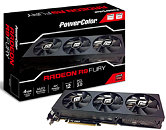Tuesday, July 14th 2015

PowerColor Announces its Radeon R9 Fury Graphics Card
TUL Corporation, a leading and innovative manufacturer of AMD graphic cards since 1997, has proudly announced a new graphics card that has the capability of the highest gaming power in the most advanced GPU ever created for PC gaming. The PowerColor R9 Fury 4GB HBM is the world's first graphics card with AMD-pioneered High Bandwidth Memory (HBM) integrated on-chip delivering 60% more memory bandwidth over GDDR5 powering performance and bleeding-edge technology.
HBM is a new type of memory chip with low power consumption, ultra-wide communication lanes, and a revolutionary new stacked configuration. HBM's vertical stacking and fast information transfer open the door for truly exciting performance in innovative form factors, not to mention that GPU applications are just the start - look for HBM's superior power efficiency and space savings to spark industry-wide innovation. PowerColor R9 Fury 4GB HBM easily handles the most graphically intense games today due to its advanced and innovative GPU to ever create for the beloved PC gaming community. This power comes from AMD-pioneered High Bandwidth Memory (HBM) integrated on-chip that delivers more than 3 times the bandwidth per watt over GDDR5 along with a 4096-bit memory interface for incredible new advances in power and efficiency which makes the most innovative total solution GPU available today.Enjoy the View. Redefine Reality.
AMD's most advanced and innovative GPU to date, the AMD Radeon R9 Fury GPU delivers the highest memory bandwidth ever for unparalleled 4K and VR gaming. Push your settings to the max with your ideal screen resolution and configuration, and get ready to redefine reality with amped support for AMD LiquidVR, DirectX© 12, Vulkan APIs, AMD CorssFire, and FreeSync technologies.
You can connect displays using 3 Display Port and 1 HDMI connector and select your operational configuration with the two-position BIOS toggle switch. PowerColor R9 Fury 4GB HBM adopts the most efficient air cooling systems that has 3 of 90mm fans, 6 of 8 mm heat pipes and a black NI plating clip. This card has it all, from great designs to even greater performances, owners of the PowerColor R9 Fury 4GB HBM will be impressed at what the Fury can do and will be gaming at the highest settings for years to come.
For more information, visit the product page.
HBM is a new type of memory chip with low power consumption, ultra-wide communication lanes, and a revolutionary new stacked configuration. HBM's vertical stacking and fast information transfer open the door for truly exciting performance in innovative form factors, not to mention that GPU applications are just the start - look for HBM's superior power efficiency and space savings to spark industry-wide innovation. PowerColor R9 Fury 4GB HBM easily handles the most graphically intense games today due to its advanced and innovative GPU to ever create for the beloved PC gaming community. This power comes from AMD-pioneered High Bandwidth Memory (HBM) integrated on-chip that delivers more than 3 times the bandwidth per watt over GDDR5 along with a 4096-bit memory interface for incredible new advances in power and efficiency which makes the most innovative total solution GPU available today.Enjoy the View. Redefine Reality.
AMD's most advanced and innovative GPU to date, the AMD Radeon R9 Fury GPU delivers the highest memory bandwidth ever for unparalleled 4K and VR gaming. Push your settings to the max with your ideal screen resolution and configuration, and get ready to redefine reality with amped support for AMD LiquidVR, DirectX© 12, Vulkan APIs, AMD CorssFire, and FreeSync technologies.
You can connect displays using 3 Display Port and 1 HDMI connector and select your operational configuration with the two-position BIOS toggle switch. PowerColor R9 Fury 4GB HBM adopts the most efficient air cooling systems that has 3 of 90mm fans, 6 of 8 mm heat pipes and a black NI plating clip. This card has it all, from great designs to even greater performances, owners of the PowerColor R9 Fury 4GB HBM will be impressed at what the Fury can do and will be gaming at the highest settings for years to come.
For more information, visit the product page.

15 Comments on PowerColor Announces its Radeon R9 Fury Graphics Card
TUL (PowerColor) and PcPartners (Sapphire) and it’s been said that Sapphire is the company that is AMD contracted to place the interposer on the reference PCB's for FuryX. Perhaps PcParters made some exclusive with AMD, that they don’t have to supply the boards as standalone, but they can as complete package so pulling in loins-share of profit. So TUL can’t get the short reference board from PcPartners, but can as complete card for the time being. This while perhaps TUL is working on their own PCB and cooler, but for whatever reason can’t be to market for several months, so PowerColor sees it as a way to get something moving.
I can’t figure a reason why TUL couldn’t have a PCB ready, was AMD holding engineering info back to get a design going. I’d think the PCB is fairly uncomplicated, surfacing mount the interposer package to a PCB isn’t tough, (though new tooling might be an issue) the power section and spec’s aren't any real obstacle, and the output connections to the DVI/D-P/HDMI straight-forward. It's almost like AMD held-off providing information, other than to Sapphire and Asus as they’re the only ones in the market. Was it AMD either didn’t trust other partners enough to even provide ambiguous pin-out and power section spec’s to get them working on their own PCB’s. Or, was AMD not in a position to make the "right deal" with PcPartners (Sapphire), and had to precluded other AIB's from opening day, as where’s XFX, Gigabyte, MSI, HIS.
Hopefully this goes about debunking such conspiracy theories (especially mine above). :oops:
I think the answer is pretty obvious. Remember when Asus and EVGA had sole distribution in the U.S. for the Titan Z ? I am betting that Fiji die production is constrained. Limited number of initial reviews with more arriving when press review boards are sent on to other sites, limited Crossfire reviews, very limited user (OcUK has a owners thread for every high-end card, the Fury X's ownership listis pitiful in comparison to any others) reviews/postings. In spite of this, the card is out of stock in a lot of markets. Kind of screams low production.
What I can't figure out is how Asus got the jump on Gigabyte, MSI, and PowerColor.
EDIT: Seems the conclusion I reached has some basis in fact
Yeah we get that OC'ing Fury is pretty much a pipe dream O tend to believe the new Interposer is a rather delicate thing connecting it all together that too much heat or voltage could litterally separate it all. I await the first one who figures out to overvolt and overclock a Fury only to find it's come undone.
At least Sapphire made an attempt. ASUS went with a massive 12 phase VRM and you can't do anything with it. They didn't even attempt to OC it or offer a dual BIOS.
I personally have no interest in overclocking Fury nor any GFX card of mine for many years. You guys all read Benchmarks right? We end up with 2-5FPS gains you would never even see unless you monitoring it.
My 7970 is "OC'd" I just used the 2nd BIOS Sapphire put on the card with the higher clocks.
Oh and I am actually planning to buy a Fury just not sure whether to go Sapphire or ASUS yet.
So agreed AMD is having production constricted, but which of like 4 parts/processes is effecting it's now harder to put a finger on where that lies. But this is a great pipe-cleaner to sort out all the teething pains ahead of the 2016 Arctic Islands and their coup of HBM2 on various R9 variants.
You can blame everyone under the sun except AMD, but at the end of the day, it is AMD that developed and contracted for the design on. Except for the HBM implementation (which would be more an architecture-to-interface issue), all three components are on mature processes. GPU on 28nm, HBM DRAM on 30nm, interposer on 65nm.
It was AMD who decided on going with their largest die in history by some margin and ally it with a complex microsolder assembly in close proximity to that die. Somehow I doubt that these factors and the subsequent lockdown of voltage control on the Fury cards are unconnected.